Bo Huang
Beijing StoneWise Technology Co Ltd
FullPart: Generating each 3D Part at Full Resolution
Oct 30, 2025Abstract:Part-based 3D generation holds great potential for various applications. Previous part generators that represent parts using implicit vector-set tokens often suffer from insufficient geometric details. Another line of work adopts an explicit voxel representation but shares a global voxel grid among all parts; this often causes small parts to occupy too few voxels, leading to degraded quality. In this paper, we propose FullPart, a novel framework that combines both implicit and explicit paradigms. It first derives the bounding box layout through an implicit box vector-set diffusion process, a task that implicit diffusion handles effectively since box tokens contain little geometric detail. Then, it generates detailed parts, each within its own fixed full-resolution voxel grid. Instead of sharing a global low-resolution space, each part in our method - even small ones - is generated at full resolution, enabling the synthesis of intricate details. We further introduce a center-point encoding strategy to address the misalignment issue when exchanging information between parts of different actual sizes, thereby maintaining global coherence. Moreover, to tackle the scarcity of reliable part data, we present PartVerse-XL, the largest human-annotated 3D part dataset to date with 40K objects and 320K parts. Extensive experiments demonstrate that FullPart achieves state-of-the-art results in 3D part generation. We will release all code, data, and model to benefit future research in 3D part generation.
Sensitivity-LoRA: Low-Load Sensitivity-Based Fine-Tuning for Large Language Models
Sep 11, 2025Abstract:Large Language Models (LLMs) have transformed both everyday life and scientific research. However, adapting LLMs from general-purpose models to specialized tasks remains challenging, particularly in resource-constrained environments. Low-Rank Adaptation (LoRA), a prominent method within Parameter-Efficient Fine-Tuning (PEFT), has emerged as a promising approach to LLMs by approximating model weight updates using low-rank decomposition. However, LoRA is limited by its uniform rank ( r ) allocation to each incremental matrix, and existing rank allocation techniques aimed at addressing this issue remain computationally inefficient, complex, and unstable, hindering practical applications. To address these limitations, we propose Sensitivity-LoRA, an efficient fine-tuning method that dynamically allocates ranks to weight matrices based on both their global and local sensitivities. It leverages the second-order derivatives (Hessian Matrix) of the loss function to effectively capture weight sensitivity, enabling optimal rank allocation with minimal computational overhead. Our experimental results have demonstrated robust effectiveness, efficiency and stability of Sensitivity-LoRA across diverse tasks and benchmarks.
AttenST: A Training-Free Attention-Driven Style Transfer Framework with Pre-Trained Diffusion Models
Mar 10, 2025Abstract:While diffusion models have achieved remarkable progress in style transfer tasks, existing methods typically rely on fine-tuning or optimizing pre-trained models during inference, leading to high computational costs and challenges in balancing content preservation with style integration. To address these limitations, we introduce AttenST, a training-free attention-driven style transfer framework. Specifically, we propose a style-guided self-attention mechanism that conditions self-attention on the reference style by retaining the query of the content image while substituting its key and value with those from the style image, enabling effective style feature integration. To mitigate style information loss during inversion, we introduce a style-preserving inversion strategy that refines inversion accuracy through multiple resampling steps. Additionally, we propose a content-aware adaptive instance normalization, which integrates content statistics into the normalization process to optimize style fusion while mitigating the content degradation. Furthermore, we introduce a dual-feature cross-attention mechanism to fuse content and style features, ensuring a harmonious synthesis of structural fidelity and stylistic expression. Extensive experiments demonstrate that AttenST outperforms existing methods, achieving state-of-the-art performance in style transfer dataset.
MANet: Fine-Tuning Segment Anything Model for Multimodal Remote Sensing Semantic Segmentation
Oct 15, 2024



Abstract:Multimodal remote sensing data, collected from a variety of sensors, provide a comprehensive and integrated perspective of the Earth's surface. By employing multimodal fusion techniques, semantic segmentation offers more detailed insights into geographic scenes compared to single-modality approaches. Building upon recent advancements in vision foundation models, particularly the Segment Anything Model (SAM), this study introduces a novel Multimodal Adapter-based Network (MANet) for multimodal remote sensing semantic segmentation. At the core of this approach is the development of a Multimodal Adapter (MMAdapter), which fine-tunes SAM's image encoder to effectively leverage the model's general knowledge for multimodal data. In addition, a pyramid-based Deep Fusion Module (DFM) is incorporated to further integrate high-level geographic features across multiple scales before decoding. This work not only introduces a novel network for multimodal fusion, but also demonstrates, for the first time, SAM's powerful generalization capabilities with Digital Surface Model (DSM) data. Experimental results on two well-established fine-resolution multimodal remote sensing datasets, ISPRS Vaihingen and ISPRS Potsdam, confirm that the proposed MANet significantly surpasses current models in the task of multimodal semantic segmentation. The source code for this work will be accessible at https://github.com/sstary/SSRS.
Bridging and Modeling Correlations in Pairwise Data for Direct Preference Optimization
Aug 14, 2024



Abstract:Direct preference optimization (DPO), a widely adopted offline preference optimization algorithm, aims to align large language models (LLMs) with human-desired behaviors using pairwise preference data. However, the winning response and the losing response within pairwise data are generated isolatedly, leading to weak correlations between them as well as suboptimal alignment performance. To address this issue, we propose an effective framework named BMC, for bridging and modeling correlations in pairwise data. Firstly, we increase the consistency and informativeness of the pairwise preference signals by targeted modifications, synthesizing a pseudo winning response through improving the losing response based on the winning response. Secondly, we identify that DPO alone is insufficient to model these correlations and capture nuanced variations. Therefore, we propose learning token-level correlations by dynamically leveraging the policy model's confidence during training. Comprehensive experiments on QA, math, and instruction-following tasks demonstrate the effectiveness of our approach, significantly surpassing competitive baselines, including DPO. Additionally, our in-depth quantitative analysis reveals the reasons behind our method's superior performance over DPO and showcases its versatility to other DPO variants.
Your decision path does matter in pre-training industrial recommenders with multi-source behaviors
May 27, 2024

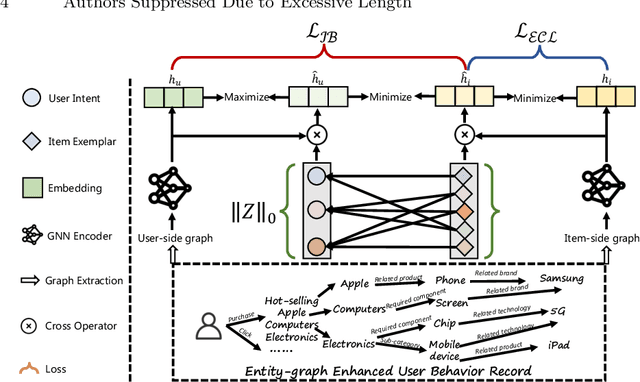

Abstract:Online service platforms offering a wide range of services through miniapps have become crucial for users who visit these platforms with clear intentions to find services they are interested in. Aiming at effective content delivery, cross-domain recommendation are introduced to learn high-quality representations by transferring behaviors from data-rich scenarios. However, these methods overlook the impact of the decision path that users take when conduct behaviors, that is, users ultimately exhibit different behaviors based on various intents. To this end, we propose HIER, a novel Hierarchical decIsion path Enhanced Representation learning for cross-domain recommendation. With the help of graph neural networks for high-order topological information of the knowledge graph between multi-source behaviors, we further adaptively learn decision paths through well-designed exemplar-level and information bottleneck based contrastive learning. Extensive experiments in online and offline environments show the superiority of HIER.
Xiwu: A Basis Flexible and Learnable LLM for High Energy Physics
Apr 08, 2024Abstract:Large Language Models (LLMs) are undergoing a period of rapid updates and changes, with state-of-the-art (SOTA) model frequently being replaced. When applying LLMs to a specific scientific field, it's challenging to acquire unique domain knowledge while keeping the model itself advanced. To address this challenge, a sophisticated large language model system named as Xiwu has been developed, allowing you switch between the most advanced foundation models and quickly teach the model domain knowledge. In this work, we will report on the best practices for applying LLMs in the field of high-energy physics (HEP), including: a seed fission technology is proposed and some data collection and cleaning tools are developed to quickly obtain domain AI-Ready dataset; a just-in-time learning system is implemented based on the vector store technology; an on-the-fly fine-tuning system has been developed to facilitate rapid training under a specified foundation model. The results show that Xiwu can smoothly switch between foundation models such as LLaMA, Vicuna, ChatGLM and Grok-1. The trained Xiwu model is significantly outperformed the benchmark model on the HEP knowledge question-and-answering and code generation. This strategy significantly enhances the potential for growth of our model's performance, with the hope of surpassing GPT-4 as it evolves with the development of open-source models. This work provides a customized LLM for the field of HEP, while also offering references for applying LLM to other fields, the corresponding codes are available on Github.
LLM-Assisted Light: Leveraging Large Language Model Capabilities for Human-Mimetic Traffic Signal Control in Complex Urban Environments
Mar 13, 2024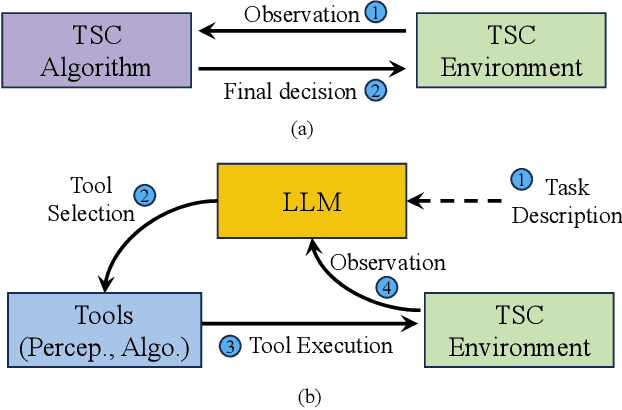
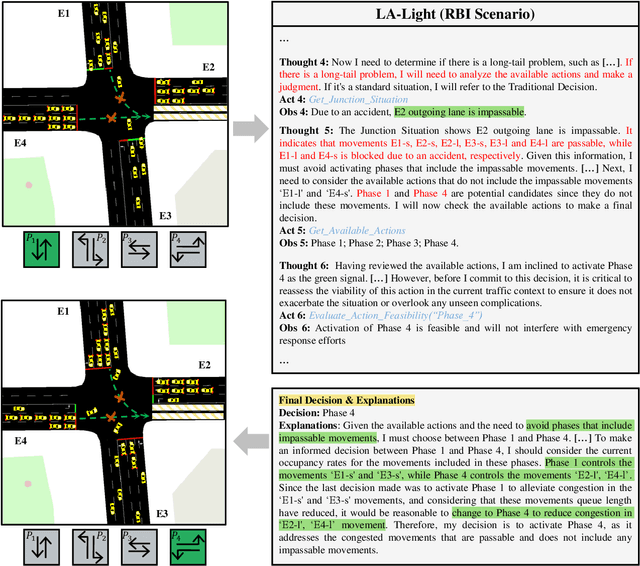

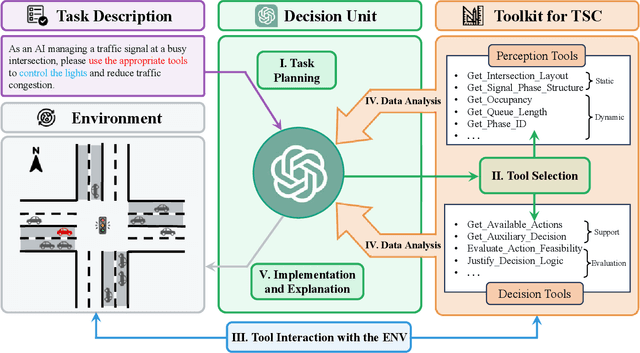
Abstract:Traffic congestion in metropolitan areas presents a formidable challenge with far-reaching economic, environmental, and societal ramifications. Therefore, effective congestion management is imperative, with traffic signal control (TSC) systems being pivotal in this endeavor. Conventional TSC systems, designed upon rule-based algorithms or reinforcement learning (RL), frequently exhibit deficiencies in managing the complexities and variabilities of urban traffic flows, constrained by their limited capacity for adaptation to unfamiliar scenarios. In response to these limitations, this work introduces an innovative approach that integrates Large Language Models (LLMs) into TSC, harnessing their advanced reasoning and decision-making faculties. Specifically, a hybrid framework that augments LLMs with a suite of perception and decision-making tools is proposed, facilitating the interrogation of both the static and dynamic traffic information. This design places the LLM at the center of the decision-making process, combining external traffic data with established TSC methods. Moreover, a simulation platform is developed to corroborate the efficacy of the proposed framework. The findings from our simulations attest to the system's adeptness in adjusting to a multiplicity of traffic environments without the need for additional training. Notably, in cases of Sensor Outage (SO), our approach surpasses conventional RL-based systems by reducing the average waiting time by $20.4\%$. This research signifies a notable advance in TSC strategies and paves the way for the integration of LLMs into real-world, dynamic scenarios, highlighting their potential to revolutionize traffic management. The related code is available at \href{https://github.com/Traffic-Alpha/LLM-Assisted-Light}{https://github.com/Traffic-Alpha/LLM-Assisted-Light}.
MetaSeg: Content-Aware Meta-Net for Omni-Supervised Semantic Segmentation
Jan 22, 2024



Abstract:Noisy labels, inevitably existing in pseudo segmentation labels generated from weak object-level annotations, severely hampers model optimization for semantic segmentation. Previous works often rely on massive hand-crafted losses and carefully-tuned hyper-parameters to resist noise, suffering poor generalization capability and high model complexity. Inspired by recent advances in meta learning, we argue that rather than struggling to tolerate noise hidden behind clean labels passively, a more feasible solution would be to find out the noisy regions actively, so as to simply ignore them during model optimization. With this in mind, this work presents a novel meta learning based semantic segmentation method, MetaSeg, that comprises a primary content-aware meta-net (CAM-Net) to sever as a noise indicator for an arbitrary segmentation model counterpart. Specifically, CAM-Net learns to generate pixel-wise weights to suppress noisy regions with incorrect pseudo labels while highlighting clean ones by exploiting hybrid strengthened features from image content, providing straightforward and reliable guidance for optimizing the segmentation model. Moreover, to break the barrier of time-consuming training when applying meta learning to common large segmentation models, we further present a new decoupled training strategy that optimizes different model layers in a divide-and-conquer manner. Extensive experiments on object, medical, remote sensing and human segmentation shows that our method achieves superior performance, approaching that of fully supervised settings, which paves a new promising way for omni-supervised semantic segmentation.
Dataset Distillation via Adversarial Prediction Matching
Dec 14, 2023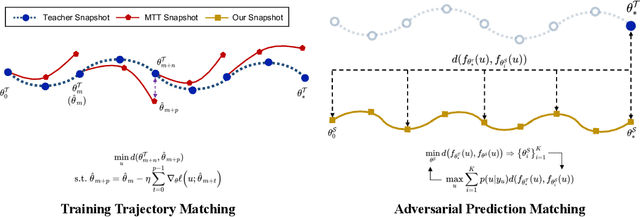


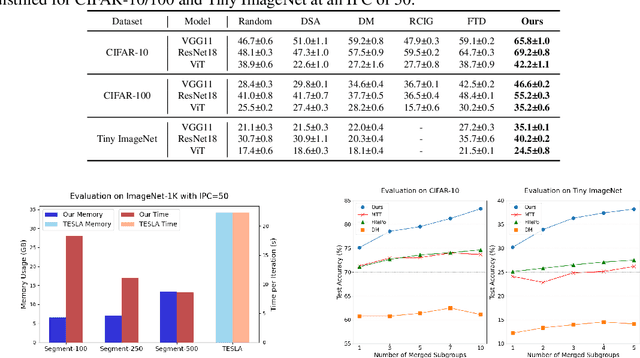
Abstract:Dataset distillation is the technique of synthesizing smaller condensed datasets from large original datasets while retaining necessary information to persist the effect. In this paper, we approach the dataset distillation problem from a novel perspective: we regard minimizing the prediction discrepancy on the real data distribution between models, which are respectively trained on the large original dataset and on the small distilled dataset, as a conduit for condensing information from the raw data into the distilled version. An adversarial framework is proposed to solve the problem efficiently. In contrast to existing distillation methods involving nested optimization or long-range gradient unrolling, our approach hinges on single-level optimization. This ensures the memory efficiency of our method and provides a flexible tradeoff between time and memory budgets, allowing us to distil ImageNet-1K using a minimum of only 6.5GB of GPU memory. Under the optimal tradeoff strategy, it requires only 2.5$\times$ less memory and 5$\times$ less runtime compared to the state-of-the-art. Empirically, our method can produce synthetic datasets just 10% the size of the original, yet achieve, on average, 94% of the test accuracy of models trained on the full original datasets including ImageNet-1K, significantly surpassing state-of-the-art. Additionally, extensive tests reveal that our distilled datasets excel in cross-architecture generalization capabilities.
 Add to Chrome
Add to Chrome Add to Firefox
Add to Firefox Add to Edge
Add to Edge